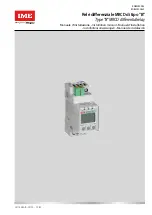
6–92
350 FEEDER PROTECTION SYSTEM – INSTRUCTION MANUAL
S3 PROTECTION
CHAPTER 6: SETPOINTS
The time to operate calculated by the formula, starts from thermal level with no load
before overload occurs, meaning the equipment temperature is considered as the ambient
temperature and its thermal level is considered equal to zero.
Eq. 9
The time to trip will start timing out once the level of the computed thermal capacity (%)
becomes higher than 100% thermal capacity (
θ
=1
). The trip flag will dropout when the
Thermal capacity falls below 97% of the pickup level.
Calculating the PICKUP setting
In some applications, it is required to apply overload factor (K-factor) to achieve the
thermal rating of the protected equipment. In such cases the pickup level need to be
calculated based on the K-factor and the base current (rated equipment current). The time
to trip is then estimated when the ratio of actual current above the programmed pickup
current is higher than 1. The pickup is calculated as follows:
Eq. 10
Where:
K = overload factor (usually provided by the equipment manufacturer)
I
base
= base current (rated current of the equipment)
The following path is available using the keypad. For instructions on how to use the
keypad, please refer to
Chapter 3 - Working with the Keypad
.
PATH
:
SETPOINTS > S3 PROTECTION > SETPOINT GROUP 1(2) > THERMAL OVLD
THERMAL OVLD FUNC
Range: Disabled, Latched Alarm, Alarm, Trip
Default: Disabled
The thermal capacity will be displayed on the relay even if the Thermal Overload
Function is set to “Disabled. The output relay #1 “Trip” will operate only if the function is
selected as a Trip and the thermal capacity value of any phase is over 100%. The LED
“ALARM” will turn on when the function is selected as a Trip or Alarm if the thermal
capacity value of any phase is over the THERMAL OVLD ALARM setting. This LED will turn
off when the thermal capacity value of all phases is below 97% of the THERMAL OVLD
ALARM setting. If Latched Alarm is selected as a function setting, the LED “ALARM” will
flash if the thermal capacity value of any phase is over the THERMAL OVLD ALARM
setting, and will stay “ON” when the thermal capacity value of all phases is below 97% of
the THERMAL OVLD ALARM setting, until the reset command is initiated.
The thermal capacity values are stored in memory and can be cleared either by using
the "Clear Thermal Capacity" command, or by cycling relay control power.
THERMAL OVLD PKP
Range: 0.05 to 20 x CT in steps of 0.01 x CT
Default: 1.00 x CT
This setting sets the level of phase current above which the thermal model starts timing
out the time-to-trip per the logarithmic formula above.
THERMAL OVLD ALARM
Range: 70.0 to 110.0% in steps of 0.1%
Default: 80.0%
This setting sets the alarm level for the accumulated thermal capacity above which the
element generates an alarm.
















































